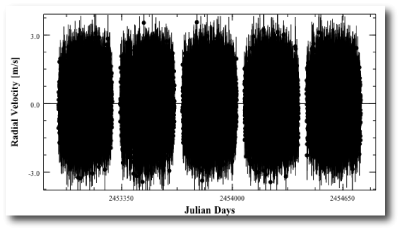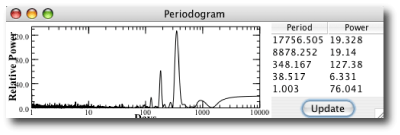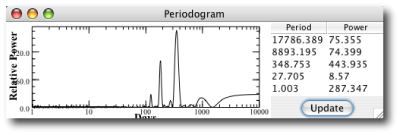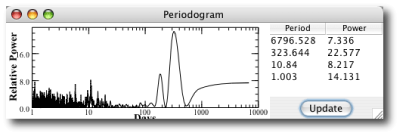Thresholds
greg posted in exoplanet detection on August 15th, 2006

Image Source.
Last week, I started a series of posts that will examine the feasibility of detecting a habitable terrestrial planet orbiting Alpha Centauri B. We want to do this from the ground, using the proven radial velocity technique. Our strategy will be to build a ~1 meter telescope in (probably) Chile with a high-precision spectrometer. The telescope will be used exclusively to obtain velocities of Alpha Centauri B, night after night, whenever the star is above the horizon, and whenever the weather is good.
At La Silla, Alpha Centauri never quite sets below the horizon. From roughly October through December, however, the star is generally too low in the sky to be adequately observed. This generates a yearly periodicity in a simulated 5-year radial velocity time series:

(Note that in the original version of last week’s post, I posted an incorrect file version of this figure. The plot has now been replaced in the post with the correct plot.)
The 96076-point time series shown above was generated by Eugenio under the assumption that we can obtain the same radial velocity precision that the HARPS spectrograph obtained on HD69830 (which is a near-twin to Alpha Centauri B). The average radial velocity error is 0.8 m/s, and the observing cadence is 200 seconds. The periodogram shows crystal clear evidence of three of the four terrestrial-mass planets in the simulated system.

The large peak in the periodogram at P=347 days corresponds to a planet with half an Earth mass. The two interior peaks are produced by planets with masses similar to Mars. If the planetary masses are doubled, that is, if the largest planet in the system has one Earth mass, then the evidence from the time series is even more overwhelming (the data set is available on the downloadable console as AlphaCenB_m2Y5):
 .
.
Now I know that scientific progress is the important issue at stake here, and I’m very excited about the upcoming Kepler mission, and the fact that it will be detecting Earth-sized planets in the habitable zones of 12-14 magnitude stars. That’ll be cool. Nevertheless, we’d like to beat Kepler to the punch. We’d like to bag the first habitable Earth-mass planet from the ground. Can we do it?
Kepler is currently scheduled for launch in October 2008. To be confident of an Earth-mass planet in the habitable zone of one of their target stars, they’ll need to see four successive transits. This means that a reasonable date for their big press conference is Dec. 21, 2012. That gives us six years.
There’s a big difference between noisily posting synthetic observations on a blog, and actually observing Alpha Centauri with a purpose-built ~5 million dollar dedicated telescope in the Southern Hemisphere. It’s safe to say that we won’t be seeing first light a year from now, and therefore we won’t have a five-year data stream by the time the current long count is up.
On the other hand, the above periodogram for the Earth-mass planet constitutes an incredibly strong detection. We can be confident in the presence of the planet with considerably less data.
So consider the following example. Let’s say that instead of obtaining HARPS-like 0.8 m/s precision, we’re only able to get 3 m/s precision. This could be the result of Alpha Centauri B showing more short-term jitter than expected, or because we don’t have enough dough to commision an absolutely state-of-the-art spectrometer. Let’s also assume that we only observe for two years rather than five. In this case, the periodogram looks like this:

We’ll definitely need to do a proper statistical analysis, but from appearances alone, “chi-by-eye”, the planet is clearly still there at the many sigma level.
September 21st, 2006 at 12:54 am
[…] Note that the downloadable console currently does not include the massive synthetic data sets for Alpha Centauri. These data were causing download times to become excruciatingly slow. Later this week, I’ll write a post which explains how the Alpha Centauri data sets can be accessed, and which also explains how the console can be updated without downloading an entire new package. (For the time being, though, you are best off just downloading a fresh copy.) […]
February 20th, 2007 at 8:06 pm
[…] One very realistic possibility is the development of an exoplanet prediction market, in which securities are issued based on particular fundamental questions involving the distribution of planets in the galaxy. Imagine, for example, that you’re an astronomer planning to devote a large chunk of your career to an all-or-nothing attempt to characterize the terrestrial planet system orbiting Alpha Centauri B. In the presence of a liquid, well-regulated exoplanet prediction market, you could literally (and figuratively) hedge your investment of effort by taking out a short position on a security that pays out on demonstration of an Earth-mass planet orbiting any of the three stars in Alpha Centauri. […]